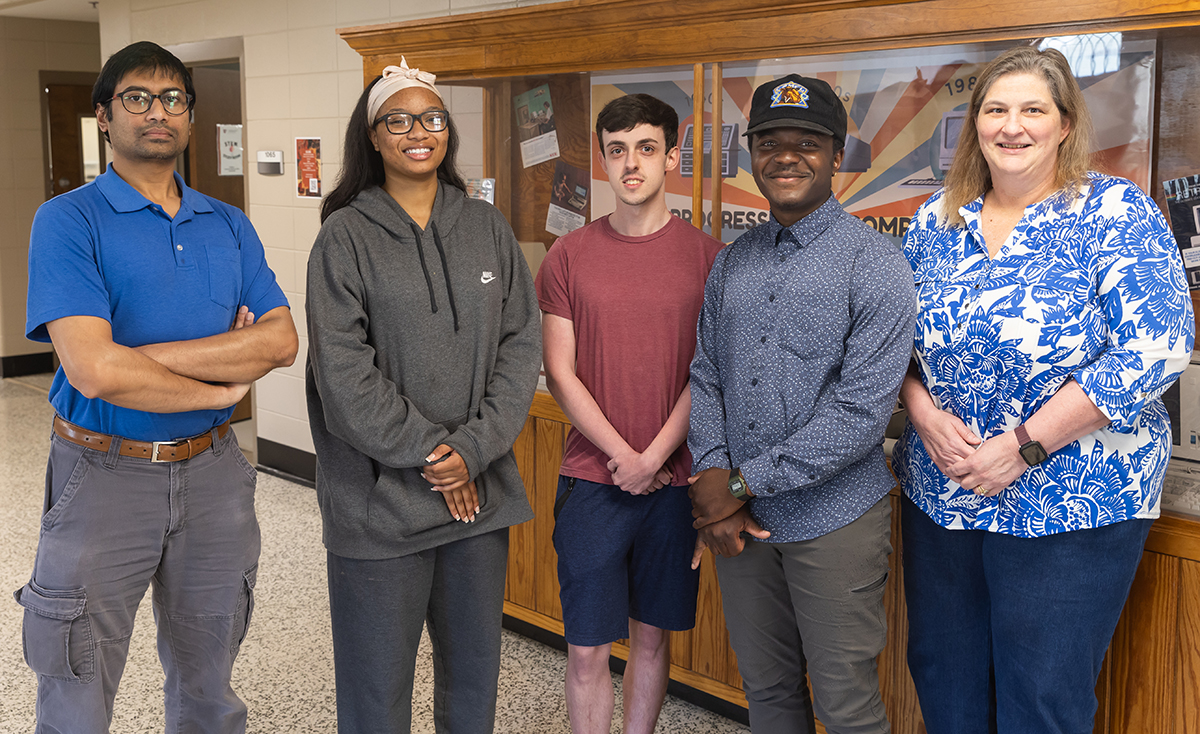April 7, 2025
25-29
Jessica Pope
Communications and Media Relations Coordinator
VSU Students Recognized at Global Math Competition

|
|
Valdosta State University's Jasmine Freeman, Timothy Smith, and Xavier Wellons recently joined 439 other students from around the world for SCUDEM IX. They were challenged to use the power and elegance of mathematics to investigate a real-world problem involving heavy metals in dark chocolate and cocoa products — and their efforts resulted in them earning a Meritorious Award. They were coached by Dr. Denise Reid, professor of mathematics, and Dr. Shafat Mubin, assistant professor of physics.
|
VALDOSTA — A three-student team from Valdosta State University was recently challenged to use the power and elegance of mathematics to investigate a real-world problem involving heavy metals in dark chocolate and cocoa products.
Jasmine Freeman, Timothy Smith, and Xavier Wellons joined 439 other students from around the world for SCUDEM (SIMIODE Challenge Using Differential Equations Modeling) IX. The global mathematical modeling competition began with each team selecting a challenge problem from physics/engineering, chemistry/life sciences, or social sciences. The students then had 25 days to develop a model using differential or difference equations followed by a 10-minute presentation to share their results with a panel of faculty and industry judges.
When the challenge period ended, Freeman, Smith, and Wellons learned their efforts had earned them the SCUDEM IX Meritorious Award.
“This mathematics challenge reinforced my problem-solving abilities and resilience when tackling complex mathematical models,” said Freeman of Union City, Georgia. She will graduate in May with a Bachelor of Science in Astronomy, a Bachelor of Science in Physics, and a Minor in Mathematics. Her ultimate career goal is to become an astrophysicist at NASA, contribute to the discovery of potentially habitable exoplanets, and advance the understanding of biosignatures and technosignatures in the universe.
“The experience has strengthened my foundation in applied mathematics and prepared me for the next chapter of my journey — whether it's in astrophysics research or contributing to groundbreaking discoveries in space exploration. It has shown me that persistence and creativity are key to pushing the boundaries of knowledge.”
SCUDEM IX was sponsored by Systemic Initiative for Modeling Investigations and Opportunities with Differential Equations (SIMIODE), a nonprofit open community of teachers who believe that helping students discover how differential equations arise — and how to build their own equations — will motivate students to learn techniques for solving textbook problems while also providing them with a real-world understanding of the power of differential equations.
“Events like SCUDEM IX encourage students to go beyond textbook problems and engage with open-ended, real-world scenarios,” said Dr. Denise Reid, a professor of mathematics in VSU’s Department of Applied Mathematics and Physics. “Students make connections between different fields such as physics, biology, and economics. Working in teams, students learn to collaborate with others and improve their communication skills. Events such as this help build student confidence and creativity and provide valuable hand-on experiences.”
Freeman, Smith, and Wellons were coached by Reid and Dr. Shafat Mubin, assistant professor of physics.
Smith of Doerun, Georgia, plans to graduate with a Bachelor of Science in Applied Mathematics in December, followed by a Minor in Applied Statistics. He hopes to pursue a career in research and data analysis, with a focus on climate cycles and geological behavior and how they impact astronomical cycles. He has been conducting research in this area for at least four years.
Wellons of Grovetown, Georgia, graduates in May with a Bachelor of Science in Astronomy, a Bachelor of Science in Physics, and a Minor in Mathematics. He currently works as a systems engineer for a contracting company, but he hopes to return to school in the future and pursue an advanced degree, possibly in aeronautics. He enjoys research and development and dreams of working with a national security-related Think Tank at some point in his career.
On the Web:
https://www.valdosta.edu/math/
VSU’s SCUDEM IX Challenge Problem:
A recent study demonstrated that some chocolate products may have high levels of heavy metals. Eating contaminated chocolate may lead to the bioaccumulation of the materials in the people who eat the chocolate treats. Assuming the results of the survey are correct, what does this imply about the long-term accumulation of heavy metals in the people who eat contaminated chocolate? To help explore this question, construct a model that will help researchers track the long-term dynamics associated with heavy metal levels in a person who consumes contaminated chocolate. Use your model to determine the long-term patterns for an individual and determine the impact for different levels of consumption. Additionally, use your model to determine what happens to children who might consume a large amount of candy at certain times of the year. For example, a child might have large amounts of candy for certain holidays as well as for their birthday. Will the trends be different for a child whose birthday is a long time before and after other major, recurring holidays? Is there a difference if a parent has the children consume their treats over a long period after a holiday rather than allowing a child to binge during the holiday?
Note: The study, “A Multi-Year Heavy Metal Analysis of 72 Dark Chocolate and Cocoa Products in the USA” was published by Frontiers in Nutrition on July 30, 2024. https://www.frontiersin.org/journals/nutrition/articles/10.3389/fnut.2024.1366231/full
Newsroom
- Office of Communications Powell Hall West, Suite 1120
-
Mailing Address
1500 N. Patterson St.
Valdosta, GA 31698 - General VSU Information
- Phone: 229.333.5800
- Office of Communications
- Phone: 229.333.2163
- Phone: 229.333.5983